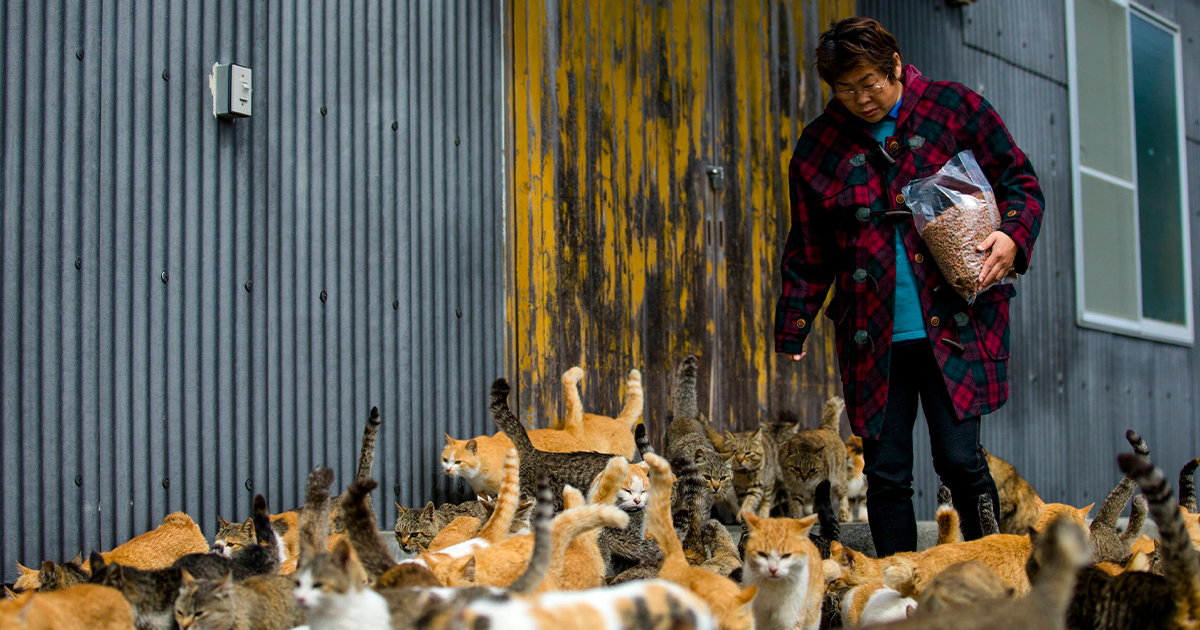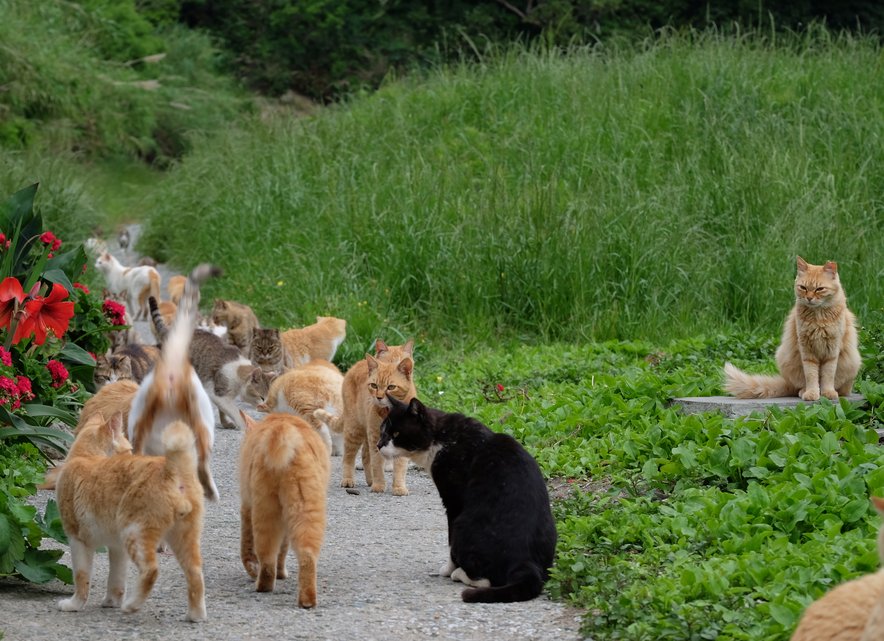A Pussycat Paradise
Aoshima Island, Japan—aka Cat Island—has a population of only five humans and over 200 feral cats. It’s a cat lover's paradise.

Japan’s Love for Cats
Japan has about a dozen cat islands—islands where cats outnumber humans. Aoshima is one of the more commonly known ones with tourists.
 Naokijp, CC BY-SA 4.0, Wikimedia Commons
Naokijp, CC BY-SA 4.0, Wikimedia Commons
Where is Cat Island?
Aoshima is an island in Ehime Prefecture, Japan. It was formerly part of Nagahama in Kita District, but as of 2005, is part of Ōzu.
How big is the island?
The island is roughly 1 mile (1.6 km) long. It does not have any hotels or restaurants and very minimal infrastructure.
What is the population on the island?
As of 2023, the island’s human population has dropped to only five. They are the only people who live on the island year-round.
 Naokijp, CC BY-SA 4.0, Wikimedia Commons
Naokijp, CC BY-SA 4.0, Wikimedia Commons
Has there always been few humans on the island?
No, actually. In 1945 the island was a fishing village with a population of around 900. As fisheries depleted and jobs moved to cities, the population dropped to only 50 residents by 2013.
And by 2019, only six elderly residents remained—which then dropped to five in 2023.
 Naokijp, CC BY-SA 4.0, Wikimedia Commons
Naokijp, CC BY-SA 4.0, Wikimedia Commons
How many cats are on the island?
The feline population has been reported to be close to 200 by 2023, up from 130 in 2018. Though this number is difficult to count as the cats roam the entire island hiding where ever they please.
 暇・カキコ, CC BY-SA 4.0, Wikimedia Commons
暇・カキコ, CC BY-SA 4.0, Wikimedia Commons
How did the cats get to the island?
The cats were originally brought to the island on ships because fisherman had a problem with rats. But the cats remained on the island and reproduced, with the feline population increasing rapidly.
 暇・カキコ, CC BY-SA 4.0, Wikimedia Commons
暇・カキコ, CC BY-SA 4.0, Wikimedia Commons
Who takes care of the cats?
The cats are feral, for the most part. Though the island is not big enough for the cats to adequately nourish themselves so they rely on food from the few residents left, tourists, and a few programs in Japan that specifically raise money to feed the cats.
What do the cats eat?
As mentioned previously, there is a food program that helps fund food for the cats on Cat Island. But the cats also rely on small rodents on the island for food, as well as food brought in by tourists.
Has the cat population ever been controlled?
In 2018, all cats on the island were to be spayed and neutered in order to lower the feline population as a response to the declining human population.
How many cats were done?
By October of 2018, a total of 210 cats had been spayed and neutered—which was nearly all of them. Ten uncaptured cats had been hidden by an elderly resident who opposed the program.
Are the cats healthy?
You may not hear much about this, but the cats on Cat Island are not regularly seen by a veterinarian, nor are they regularly taken care of—thus, diseases are present, and rarely talked about. Many kittens pass shortly after birth.
Can tourists go to Cat Island?
Technically, yes, but Aoshima Island is not made for tourists. There are no cars, hotels, restaurants or even vending machines in the island. Residents are mostly elderly who have help from distant family.
 そらみみ, CC BY-SA 4.0, Wikimedia Commons
そらみみ, CC BY-SA 4.0, Wikimedia Commons
How do tourists get to the island?
Aoshima is only accessible by ferry departing from JR Iyo-Nagahama Station in Port Nagahama. There are only two rounds of ferries per day, and the trip takes about 30 minutes each way.
 暇・カキコ, CC BY-SA 4.0, Wikimedia Commons
暇・カキコ, CC BY-SA 4.0, Wikimedia Commons
Can tourists interact with the cats?
Yes, the cats on Cat Island are feral. They roam the entire island and can be seen, fed, and played with by anyone who approaches them. It is important to remember that these cats are friendly, but they are not domesticated. Tourists should always be respectful and cautious.
Can tourists help the cats?
Tourists are welcome to bring food donations for the cats. Some people even bring toys and accessories to leave behind for the cats.
In fact, tourist donations didn’t start until recently when a local made a public cry for help.
Social Media to the Rescue
In 2016, local Kazuyuki Ono, 59, made a plea on Twitter when he noticed a lack of food for the cats. Word spread quickly through multiple social media platforms and donations began pouring in from across the country.
Since then, tourists regularly visit the island bringing donations along with them.
When is the best time to visit Cat Island?
Although weather conditions in the summer months are better for accessibility, there is a need for tourists and donations in the winter months when natural food supplies (ie. Rodents) are scarce for the cats.
Can tourists go to Cat Island in the winter?
Yes. However, the ferry may not run as often due to poor weather conditions and rough seas. Residents do their best to stock up on food supplies during the nicer months and ration the cats throughout the winter.
 ブルーノ・プラス, CC BY-SA 4.0, Wikimedia Commons
ブルーノ・プラス, CC BY-SA 4.0, Wikimedia Commons
Controversy on Cat Island
Cat Island remains a topic of controversy as some people believe it to be a feline paradise while others believe the cats to have a low quality of life, given their feral living conditions.
Research Studies
Some researchers who have studied Aoshima discovered that the cats organize themselves in a hierarchy. The males secure the territory, while the females are responsible for food.
However, this creates competition which leads to starvation, disease, and infanticide.
A Feline Paradise
Those who believe the island to be a feline paradise say that the island provides the cats with a safe and comfortable home where they “lie about in the street sunning themselves all day.”
The residents of the island are among those who believe it to be a favorable home for the cats.
Tashirojima
Tashirojima is another famous cat island in Japan. It is a small island off the mainland of Japan and has a human population of only 100, with a feline population doubling that.
No Dogs Allowed
Because the cats are so widely respected on Tashirojima, there are no pet dogs allowed on the island. This is commonly practiced on Aoshima as well, though tourists are usually cat-lovers and don’t often bring their dog along anyway.
Good Luck
Locals believe that feeding cats will bring wealth and good fortune. Thus, the cats on these islands have become a sort of mascot for the islands, and caring for them has become a priority.
Final Thoughts
If you’re a cat lover, Aoshima Island in Japan should be next on your bucket list. Pack yourself some snacks, and bring some along for your feline friends and enjoy a day in pussycat paradise.
 YAMASA, ShutterstockSources: 1, 2
YAMASA, ShutterstockSources: 1, 2
























